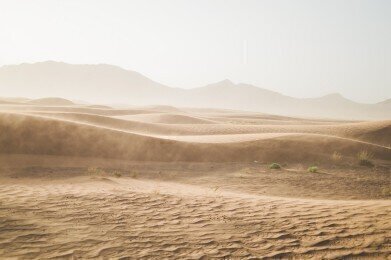Air Clean Up
How Does Pollution Spread from the Sahara Desert?
Jul 07 2020
At 3.5 million square miles in size, the Sahara Desert is the largest expanse of arid territory that is not located at either of the poles. As well as being an incredibly dry and sandy place, the desert can also experience hurricane-strength speed winds, which cause extreme dust storms and reduce local visibility to almost zero. Much of that dust is also blown over to neighbouring communities and even further afield, exacerbating the health conditions of those living there.
This is because the dust from the Sahara Desert can mix with previously existing contaminants in the air to create damaging particles of pollution, such as particulate matter 2.5 (PM2.5). Small enough to be breathed into the lungs and even ingested into the bloodstream, PM2.5 can play havoc with the body’s internal organs. In fact, a recent study has even linked elevated levels of pollution caused by the Sahara Desert with a spike in infant mortality rates in the regions bordering the desert.
Far-reaching winds
Sandstorms have minimum speeds of at least 25 miles per hour (and sometimes far higher), meaning that the Sahara is the largest source of windblown dust anywhere on Earth. In fact, it’s estimated that winds in the region whip up hundreds of tera-grams of dust each year, creating enough debris to fill over 10 million bin lorries!
In particularly windy times of the year, the dust can be pushed right across northern Africa and over the Mediterranean Sea or even the Atlantic Ocean, ending up in places as far away as the UK, Florida and the Bahamas. En route, the dust mixes with particles already present in the air to create even more damaging types of pollution, which can cause or exacerbate the symptoms of pre-existing health conditions, such as asthma or other lung conditions.
However, it’s the populations closer to home which are more vulnerable to the Saharan winds. It’s estimated the desert itself is home to approximately 2.5 million people, while countless more live on its fringes and as such are susceptible to prolonged exposure to the most adverse effects of the extreme winds.
Young lungs at risk
Indeed, a new study from Stanford University in California have discovered that increased Saharan dust storms have a direct impact on infant mortality rates in the region. The researchers analysed birth data from 30 different countries throughout sub-Saharan Africa, covering over one million new-born babies. They then cross-referenced those results with the data gathered by revolutionary outdoor monitoring software for PM2.5 to determine how the latter impacted the health of young children.
Their findings made for concerning reading. They discovered that in years when Saharan pollution increased by 25%, there was a corresponding 18% spike in the numbers of child deaths. Indeed, exposure to PM2.5 caused by dust storms from the Sahara Desert was responsible for 400,000 infant fatalities in 2015 alone. It has been suggested that using groundwater to dampen the sand may prevent it from becoming airborne in the first place, thereby limiting the spread of the pollution.
“Africa and other developing regions have made remarkable strides overall in improving child health in recent decades, but key negative outcomes such as infant mortality remain stubbornly high in some places,” explained Marshall Burke, one of the contributors to the study. “We wanted to understand why that was, and whether there was a connection to air pollution, a known cause of poor health.”
Events
Apr 22 2024 Hannover, Germany
Apr 23 2024 Kuala Lumpur, Malaysia
Apr 24 2024 Sao Paulo, Brasil
May 05 2024 Seville, Spain
May 13 2024 Munich, Germany














